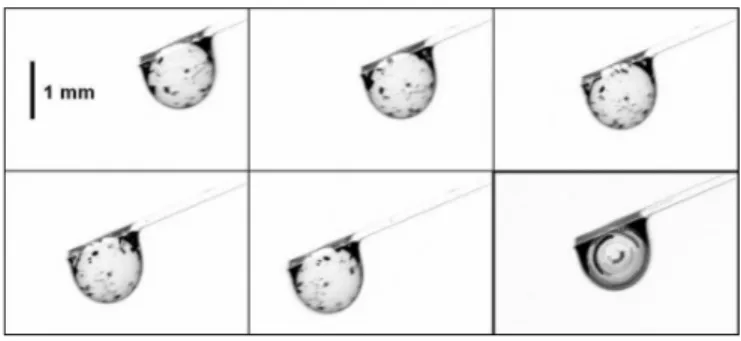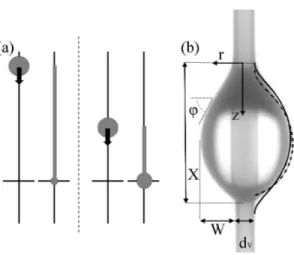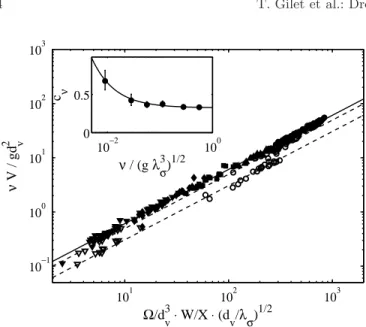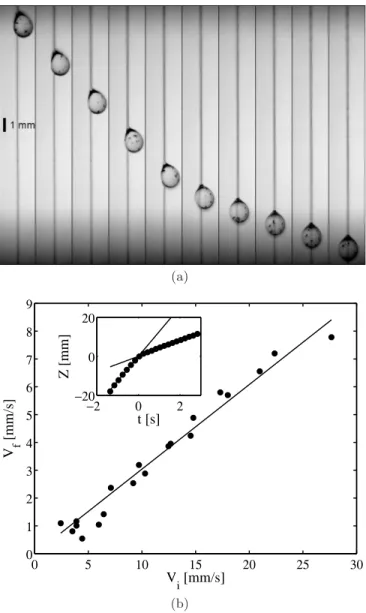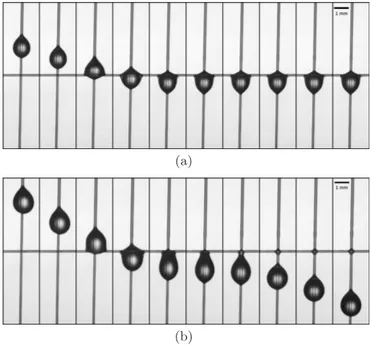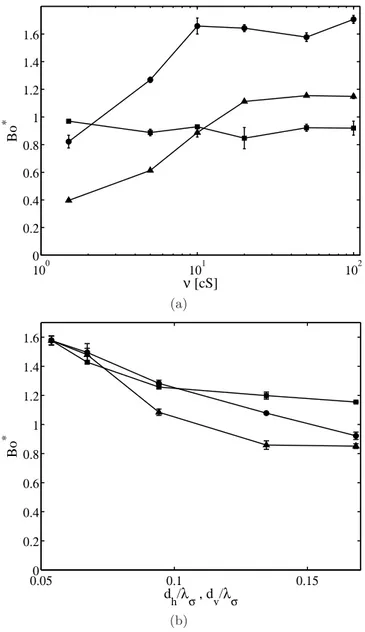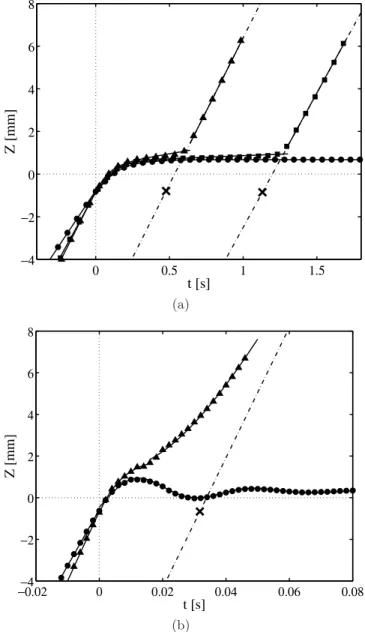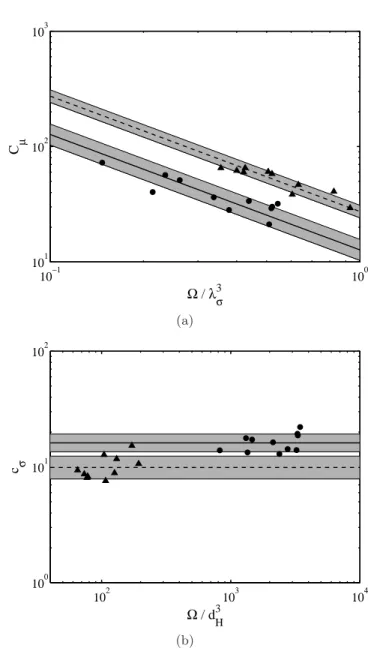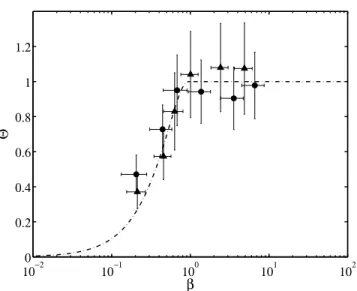(will be inserted by the editor)
Droplets sliding on fibres
T. Gilet1, D. Terwagne2, and N. Vandewalle2 1Department of Mathematics, Massachusetts Institute of Technology, Cambridge, MA 02139, USA
2
GRASP, University of Liege, 4000 Liege, Belgium Received: date / Revised version: date
Abstract. We present the results of a combined experimental and theoretical investigation of oil droplets sliding on fibres. First, both the axisymmetric shape and the motion of a droplet on a vertical fibre are described. The motion is shown to result from a balance between the droplet weight and the viscous stresses. On a long-term range, the droplet loses some mass through coating the fibre, which decreases its velocity. In a second time, we rationalize the behaviour of a droplet that encounters a junction between vertical and horizontal fibres. Depending on its size, the droplet may cross the junction or remain blocked. The transition is well-described by an ordinary differential equation equivalent to a damped harmonic oscillator truncated to the neighbourhood of the horizontal fibre. This simple system is the basic element for more complex fiber networks that would be useful in microfluidic applications involving droplets. PACS. PACS-key discribing text of that key – PACS-key discribing text of that key
1 Introduction
In the early morning, the spider webs in our gardens are often covered with a myriad of dew pearls. At dawn, the fresh and humid air condenses into a thin water film on the threads. Quickly, this film turns into a string of droplets, the smallest of which stay on the web and wait for the first sunbeams to evaporate again. The biggest slide and roll along the web (Fig. 1), collide and fuse together, leave pearls in their wake, and sometimes fall from the web. Can these ’arachnidean’ constructions inspire new directions for microfluidics?
Fig. 1. An oil droplet (ν = 100 cS) slides and rolls along a fibre of diameter 140 µm. Snapshots are taken every 50 ms. The background, including the originally dry fibre, is subtracted in order to reveal the micrometric coating film left in the wake of the droplet. The last picture corresponds to the sum of the formers; the particles within the droplet follow some circular paths, indicating that the droplet rolls on the fibre.
Droplets on fibres are omnipresent in nature, they are already involved in many applications, e.g. the microscale alignment of fibres [21] or the clogging of fibre filters [4, 26]. Nevertheless, since the pioneering work of Joseph Plateau [18], physicists have rather investigated the flows of liquid films on threads [10, 5, 8] and a relatively small number of studies were dedicated to the interactions between individ-ual droplets and fibres. Plateau [18] has already observed that, due to surface tension only, a liquid covering a fibre spontaneously turns into a string of pearls called unduloid. A similar instability is observed for falling cylindrical jets, as rationalised a few years later by Lord Rayleigh [20]. The instability of a thin film on a fiber is developed extensively in Yarin et al. [27] and references therein. Nevertheless, droplets may take other shapes than the one proposed by Plateau. For example, the axisymmetry of the shape is broken down by gravity for large droplets on a horizontal fibre. If the liquid does not perfectly wet the fibre (e.g. pure water on nylon), the droplet cowers on one side of the fibre without wrapping it [3, 17]. Such droplets often hang at rest on a vertical fibre [11]; their weight is bal-anced by a bottom-up difference in contact angle. Tiny droplets may be set into motion on horizontal fibres in several ways, e.g. with temperature gradients [25], thanks to a gas flow [6], or when the fibre is conical [16]. Sliding droplets have also been studied in other geometries, e.g. on an inclined plane [13, 22] or as slugs in a tube [2].
In this manuscript, we observe experimentally the gravity-induced motion of droplets on fibre networks, focusing on droplets that perfectly wet the fibres and slide on them. In section §3, we start by rationalising the behaviour of a droplet sliding on a vertical fibre thanks to gravity.
Fig. 2. (a) The droplet size is tuned by changing the height of release and so the coating length. (b) Axisymmetric shape of an oil droplet on a vertical nylon fibre. The dash-dotted and solid lines correspond to the numerical solutions of Eq.(1) with and without the gravity term respectively.
We proceed in §4 by observing the interaction between a droplet and an intersection between two fibres.
2 Experimental method
Fibers made of nylon (fishing thread) are tight on a metal-lic frame. The tension in the fibres is supposed to be of negligible influence on the droplet motion. Droplets are made of silicon oil (Dow Corning 200) though the results may be generalised to any liquid that completely wets the fibre. Experiments involve fibres of 5 different diam-eters (80, 100, 140, 200 and 250 µm) and droplets with six different kinematic viscosities ν (1.5, 5, 10, 20, 50 and 100 cS); the corresponding density ρ is respectively (0.85, 0.91, 0.93, 0.95, 0.96 and 0.96 g/cm3). Droplets are
di-rectly released on the fibres with a syringe. The droplet size is varied by changing the needle diameter. Moreover, moving the release point on the fibre allows to tune the volume of the droplet when it enters a specified region of interest. Indeed, as explained below, the droplet loses some mass by coating the fibre; so the greater the distance between the release point and the region of interest, the smaller the resulting droplet (Fig. 2a). About 500 droplets have been filmed from the side with a high-speed camera (recording frequency up to 1000 fps). Measurements are made by image processing (Fig. 2b).
3 A droplet sliding on a vertical fibre
3.1 Geometry
On a vertical fibre of diameter dv, wetting droplets take an
axisymmetric shape of volume Ω, close to the unduloid of Plateau (Fig. 2b), dimensions (width W and extension X)
of which are represented as a function of Ω in Fig. 3(a-b). This shape is computed theoretically as [r(s), z(s), ϕ(s)], where s is the curvilinear coordinate along a meridian of the interface (Fig. 2b). If we suppose a balance be-tween gravity g and surface tension σ, the Laplace equa-tion yields dsr = cos ϕ, dsz = sin ϕ, dsϕ = P σ − sin ϕ r + z λ2 σ , (1)
where P is the overpressure within the droplet at loca-tion z = 0, and λσ = pσ/ρg is the capillary length.
Nevertheless, if this balance of gravity and surface ten-sion was effective, the droplet would stay at rest on the fibre. The observed sliding of the droplet suggests that viscous stresses have to be taken into account. Therefore, we may suppose that these stresses balance gravity, and that surface tension forces balance themselves. To assess this hypothesis, Eq. (1) is solved numerically as an ini-tial value problem, the boundary condition in s = 0 being r(0) = dv/2, z(0) = 0 and ϕ(0) = π/2. The integration is
stopped as soon as r = dv/2 again. The scenarios
includ-ing and neglectinclud-ing the gravity term z/λ2
σ are considered
successively. The comparison with measurements (Fig. 2b and 3b) clearly confirms this second scenario. The solu-tion taking gravity into account cannot explain vertical extensions X as large as those observed experimentally. Gravity can thus be neglected in the Laplace equation and the unduloid is a good approximation for the droplet shape.
Although the unduloid cannot be described with a sim-ple explicit equation, it is possible to find some analytical expressions in the asymptotic regimes Ω ≫ d3
v and Ω ≪
d3
v. Large droplets (Ω/d3v > 104) tend to keep their
spher-ical shape when they are hanged on a fibre. The sphere of radius R, described by (r0, z0, s0) = R(sin ϕ, 1 − cos ϕ, ϕ)
satisfies Eq. (1) for ∆p = 2σ/R ≪ 1 but not matching conditions on the fibre. On the other hand, the matching zone involves a very small amount of liquid so the volume of the droplet is approximately equal to the volume of the sphere. Therefore, we infer
W dv ≃ µ 3Ω 4πd3 v ¶1/3 and X = 2W. (2)
These scalings are similar to those discussed in Lorenceau et al. [16]. When the droplet size is smaller than dv, the
droplet spreads on the fibre in such a way that the curva-ture of its interface is only slightly lower than the fibre cur-vature 2/dv. Therefore, we can infer the asymptotic
solu-tion by perturbing the solusolu-tion (r0, z0, ϕ0) = (dv/2, s, π/2)
when Ω = 0 (corresponding to the fibre itself). Supposing that ∆p = 2σ(1 − ε)/dv and that the perturbations are
denoted by tilted variables, we obtain dsr ≃ − ˜˜ ϕ, dsz ≃ 0,˜ dsϕ ≃˜ 4˜r d2 v −2ε dv , (3)
10−1 100 101 102 103 104 10−2 10−1 100 101 Ω / d V 3 W / d V (a) 10−1 100 101 102 103 104 100 101 102 Ω / d V 3 X / d V (b)
Fig. 3. (a) Width W and (b) extension X of a droplet of volume Ω on a fibre of diameter dv. The dashed line represents
the asymptotic scalings (2) and (5). The solid line (resp. dash-dot line) corresponds to the numerical solution of (1) without (resp. with) considering the gravity term z/λ2
σ. In (b), the solution with gravity does not predict extensions X as large as those
measured.
from which we find a droplet shape close to a sinusoid. r z ϕ = dv 2 · 1 + ε µ 1 − cos2s dv ¶¸ s π 2− ε sin 2s dv . (4)
The vertical extension X is equal to πdv, which
corre-sponds to the fibre perimeter. Both the thickness and the volume of the droplet are easily computed from (4):
W dv = ε = 8Ω π2d3 v and X dv = π. (5)
As seen in figure 3, the asymptotic laws (2) and (5) give an accurate picture of the dimensions of both large and small droplets sliding on a vertical fiber. The droplet shape has a direct influence on the sliding motion, as shown in the next section.
3.2 Short-term steady motion
The motion of a droplet on a vertical fibre involves several effects, each of them having a specific timescale. Starting from rest, the droplet first accelerates and quickly reaches (in less than 0.1 s) a limit speed V where viscous effects balance gravity, as shown indirectly in the previous sub-section. The trajectory of the droplet center of mass is given by the Newton law:
ρΩdV
dt = ρΩg − Fν, (6)
where Fν is the friction force coming out from viscous
effects. This friction is due to velocity gradients within the
droplet, that Lorenceau et al. [15] proposed to estimate as CνV X/2W z. Here, z is the distance to the nearest contact
line and Cν a proportionality factor that may depend on
surface tension among others. The resulting viscous force is Fν = 2πdv Z X/2 0 CνµV z X 2Wdz, (7)
where µ = ρν is the dynamic viscosity of the droplet. This integral diverges due to the singularity at contact point (z = 0). In order to solve this paradox, De Gennes [7] proposed to integrate from z = a ∼ 10−9
m – the characteristic length of the molecular film covering the fibre – instead of z = 0. This yields
Fν = πCναµdvX
WV, (8)
where
α = ln(X/2a) ≃ 15. (9)
Balancing this force with the droplet weight ρgΩ gives νV gd2 v = 1 πCνα W X Ω d3 v . (10)
A similar scaling is found in [16] and [9]. As previously seen (Fig. 3), the dependence of W/X on Ω/d3
v is complex in
the general case, but droplets sufficiently large compared to the fibre tend to be spherical so W/X → 0.5. Equation (10) is in excellent agreement with experimental results (Fig. 4), whatever the fibre diameter dv, provided that Cν
satisfies Cν= cν r λσ dv ⇒ νV gd2 v = πcνα r dv λσ W X Ω d3 v . (11)
101 102 103 10−1 100 101 102 103 Ω/d v 3⋅ W/X ⋅ (d v/λσ) 1/2 ν V / gd v 2 0 10−2 100 0.5 ν / (g λσ3)1/2 c ν
Fig. 4. Short-term balance: normalized velocity νV /gd2 v as a
function of the normalized volume Ω/d3
v. Black (resp. white)
symbols correspond to viscosity ν ≥ 10 cS (resp. ν < 10 cS). (◦,•) dv = 80 µm, (N) dv = 100 µm, (¥) dv = 140 µm,
(¨) dv = 200 µm, (H,▽) dv = 250 µm. The solid line
rep-resents Eq. (11) where cν takes its high-viscosity value (0.33).
The dashed line is Eq. (11) in the low-viscosity regime, i.e. cν> 0.33. (Inset) Coefficient cνas a function of the normalised
viscosity ν/pgλ3
σ. The solid line corresponds to Eq. (12).
The factor pdv/λσ clearly indicates that gravity is not
perfectly balanced by viscous effects, and that surface ten-sion also plays a role in the droplet limit velocity. The co-efficient cν is of the order of unity; it slightly depends on
the viscosity when this one is lower than 10 cS. The fol-lowing empirical law is proposed to fit the measurements (inset of Fig. 4), cν= 0.33 µ 1 + 0.01pgλ 3 σ ν ¶ . (12)
The viscosity ν is here made dimensionless by the factor pgλ3
σ, which only involves g, σ and ρ.
We can now estimate the acceleration time of the droplet from Eq.(6): ta ∼ V g = 1 πcνα r dv λσ W X Ω dvν , (13)
and check that, for a maximal velocity of 1 m/s, the steady regime is reached after 0.1 s. The balance (10) between gravity and viscous forces is therefore quickly effective, it determines the droplet velocity along the fiber.
3.3 Long-term mass loss
The coating of a solid by a liquid has been deeply inves-tigated since the pioneering work of Landau and Levich [12]. The so-called LLD theory rationalises the coating of
a plate slowly pulled out of a liquid bath. It was general-ized later to other geometries, including a fiber pulled out from a bath ([19] and references therein). In that case, the thickness δ of the coating film is given by
δ dv = cw
Ca2/3 with Ca= µV
σ , (14)
where Ca is the capillary number and the wetting constant cw = 0.67 according to the authors. Many corrections
(gravity, inertia, geometry, wetting, etc.) can be imple-mented by simply changing this factor cw[19]. For
exam-ple, cw= 1.07 when the fibre crosses the interface between
two immiscible liquids [1, 2].
Sliding droplets are observed to coat fibres in the same way as if these latter were pulled out of a bath. Conse-quently, the droplets lose some mass through coating and progressively slow down as they move on the fibre. Equa-tion (14) may be applied to predict the mass loss and be coupled to (11) in order to get the long-term trajectory of the droplet. Denoting by Z the vertical position of the droplet mass centre (so ˙Z = V ), the volume variation ˙Ω is ˙ Ω = −πdvδ ˙Z = −πcwd2v µ µ σ ¶2/3 ˙ Z5/3. (15) We proceed by differentiating (11) with respect to time, supposing that W/X is constant:
˙ Ω = πcναX W r λσ dv νdvZ¨ g . (16)
Both equations yield
¨ Z = −w ˙Z5/3with w = −ccw να W X r dv λσ µ µ σ ¶2/3 gdv ν , (17) where the parameter w only depends on physical con-stants. This equation is integrated twice;
Z = ˙ Zi 1/3 − µ ˙ Zi −2/3 +23wt ¶−1/2 w/3 , (18)
where ˙Zi is the initial velocity of the droplet. The
long-term trajectory (vertical position on the fiber as a function of time) is measured for droplets with various parameters (size and viscosity). The experimental results are com-pared to the predictions of Eq. (18) in Fig. 5. The initial velocity ˙Ziis fitted on the experiments, and w is computed
by successively taking cw = 0.67 and cw= 1.5. This
sec-ond value gives an accurate description of the long-term trajectory, whatever the droplet viscosity or size. Finally, we check a posteriori that the ratio W/X is approximately constant during the measurement period. Typically, W/X variations become significant when Ω is varied by a factor 10, which happens after about 5.5/(w ˙Zi
2/3
), i.e. after 89 s for the (H)-curve in Fig. 5.
0 10 20 30 40 50 0 0.02 0.04 0.06 0.08 0.1 0.12 0.14 0.16 t [s] Z [m]
Fig. 5. Long-term trajectories Z(t) of droplets with various viscosities and initial sizes on a fibre of diameter dv= 250 µm:
(•) ν = 10 cS, (N) ν = 20 cS, (¥) ν = 50 cS, and (H) ν = 100 cS. The solid line (resp. dashed line) corresponds to Eq. (18) in which cw = 1.5 (resp. cw = 0.67). The initial
velocity ˙Ziin Eq. (18) is fitted on the experimental data.
3.4 Shape transition
The droplet shape on a fibre is not always axisymmet-ric and unique; several equilibrium configurations may co-exist, some being more stable than others [17]. We have seen that some 100 cS droplets sliding on a vertical fibre can remain in a metastable asymmetrical shape. At any moment, these droplets quickly switch to the well-known axisymmetrical configuration. By the way, the friction is considerably increased and the droplets immediately slow down (Fig. 6a). The inverse transition has never been ob-served and is likely impossible. The transition point seems to be arbitrary, the exact nature of the transition is still unknown.
The velocity Vf of the final symmetrical shape has
been measured as a function of the initial velocity Vi
be-fore the transition, for 100 cS droplets on various fibres (Fig. 6b). Data suggest
Vf≃ 0.30Vi, (19)
so the friction coefficient cν is about 3.3 times less in the
asymmetrical configuration.
We have observed a similar transition on inclined fi-bres, though both configurations are asymmetric in that case (Fig. 7). The centre of mass of the droplet slightly moves toward the fiber, which leads to increased veloc-ity gradients and consequently an increase in the friction force. However, the resulting velocity is only decreased by a factor 2 during the transition.
(a) 0 5 10 15 20 25 30 0 1 2 3 4 5 6 7 8 9 V i [mm/s] V f [mm/s] −2 0 2 −20 0 20 t [s] Z [mm] (b)
Fig. 6. (a) A 100 cS droplet slides along a vertical fibre of diameter dv = 160 µm. Snapshots are taken every 160 ms.
The initially asymmetrical shape suddenly becomes symmet-ric, which decreases the droplet velocity from 18 mm/s to 5.7 mm/s. (b) Velocity of the symmetrical shape Vf as a
func-tion of the velocity of the corresponding asymmetrical shape Vi. The solid line corresponds to Eq. (19). (Inset) Typical
tra-jectory Z(t) of a droplet experiencing a shape transition in t = 0. The solid lines represent constant velocity trajectories.
4 Intersection between two fibres
We proceed by discussing the behaviour of droplets as they encounter an intersection between two fibres. The junction is simply made by placing a horizontal fibre next to the vertical one so they just touch each other; contact is ensured by the tension of both fibres.
Droplets are released on the vertical fibre, upstream from the intersection. As already noted in [9], two scenar-ios are observed: small droplets remain pinned on the node (Fig. 8a) while larger droplets cross the intersection and keep sliding downwards (Fig. 8b). The trapping of small
Fig. 7. A 100 cS droplet slides along an inclined fibre of di-ameter dv = 140 µm. Snapshots are taken every 320 ms and
superposed together. The shape transition increases the fric-tion, so decreasing the velocity from 6 mm/s to 3 mm/s.
droplets is mainly due to the capillary forces developed by the horizontal fibre. On the other hand, large droplets are likely too heavy to hang on the horizontal fibre. Lorenceau et al.[15] have already investigated a problem that involve nearly the same mechanism, i.e. falling droplets that im-pact a horizontal fibre. We note however that droplets in free fall have a much larger velocity, so in addition the droplet inertia has to be considered.
The balance between gravity and surface tension is the Bond number related to the fibre, defined as
Bo= ρΩg 2πσdh
, (20)
where dh is the diameter of the horizontal fibre. A sharp
transition is observed between blocking and crossing regimes (Fig. 9a); there is a critical Bond number Bo∗
∼ 1 above which droplets cross the node and below which they are blocked. The intersection behaves as a fluidic diode. This Bo∗
depends on the droplet viscosity ν, at least when this latter is small.
When crossing, a tiny amount of liquid is still trapped by the horizontal fibre, so the droplet mass (and cor-responding Bond number Bof) after crossing is slightly
lower than before (Boi). Although this volume cannot be
accurately measured, it should scale as the ”volume” of the intersection, namely dhdv(dh+ dv).
Large high viscosity droplets may experience signifi-cant delays (sometimes as long as several seconds) when they cross the intersection (Fig. 10). This delay time th
is shown to diverge as Bo → Bo∗
, as often in physics when a potential barrier is just crossed (Fig. 9b). Accord-ing to the experimental data, th is proportional to the
kinematic viscosity ν of the droplet, so the data collapse on a single curve when the dimensional group th/ν
(mea-sured in s2m−2
) is represented instead of th. Note that
the divergence is not observed for low viscosity droplets whose crossing time remains small.
As already seen in Fig. 9, the threshold Bond number Bo∗
increases with the droplet viscosity, and saturates to
(a)
(b)
Fig. 8. A 5 cS oil droplet interacts with a junction between two nylon fibres (diameter 140 µm). Snapshots are taken every 10 ms. The intersection behaves as a fluidic diode: (a) A small droplet is pinned on a junction that (b) a large droplet is able to cross. In that latter case, a tiny amount of liquid is left at the intersection.
a limit value in the high viscosity regime where delays are observed. The critical viscosity above which Bo∗
is con-stant depends on the fibre diameter (Fig. 11a). In general, Bo∗
decreases with increasing fibre diameter (Fig. 11b) in a non-obvious way.
4.1 Modelling
In order to model the behaviour of a droplet interact-ing with a junction between two fibres, we have first to measure and analyse the droplet trajectory. Observations are again qualitatively different depending on the viscos-ity regime. As already mentioned, high viscosviscos-ity droplets cross the junction with a delay time that increases as they approach the threshold Bo∗
(Fig. 12a). Small droplets are smoothly blocked, and the trajectory is always monotonic. Low viscosity droplets do not experience any significant delay when crossing is allowed. Moreover, small blocked droplets largely oscillate before coming to rest on the node (Fig. 12b).
These experimental results strongly suggest to model the droplet as a damped harmonic oscillator whose restor-ing force is truncated to the neighbourhood of the node. Assuming that the position Z of the droplet mass centre is counted from the intersection (thus corresponding to Z = 0), we introduce a characteristic function χ[−Z1,Z2](Z) equal
to 1 when −Z1 < Z < Z2 and 0 otherwise. The droplet
starts touching the node when Z = −Z1< 0 and detaches
0 0.5 1 1.5 0 0.5 1 1.5 Bo i Bo f (a) 0 0.5 1 1.5 103 104 105 Bo i t h / ν [s 2 m −2 ] (b)
Fig. 9.(a) Relationship between the volume of liquid allowed to cross the node and the initial droplet volume, expressed in terms of Bond numbers Bof(Boi). The solid lines correspond
to equations Bof = 0 when Boi< Bo∗ (blocking) and Bof =
Boi−0.05 when Boi> Bo∗(crossing). (b) Time t
h[s] needed by
the droplet to cross the intersection, as a function of Boi. The
solid line is the empirical law th/ν = 900/(Boi− Bo∗), where
the dimensional prefactor is 900 s2
m−2. (a-b) Experimental
data for dh = 250 µm and dv = 80 µm: (◦) ν = 1.5 cS, (△)
ν = 5 cS, (¤) ν = 10 cS, (▽) ν = 20 cS, (♦) ν = 50 cS and (⊳) ν = 100 cS. Error bars typically correspond to the symbol size. The dashed lines correspond to the Bo∗values.
oscillator is
ρΩ ¨Z + CµµΩ1/3Z + kZχ˙ [−Z1,Z2](Z) = ρΩg, (21)
where Cµ is the friction coefficient and k is the stiffness of
the spring mechanism related to the horizontal fibre, so k = cσ dh
Ω1/3σ, (22)
Fig. 10. A delay of about 0.5 s is observed when a 50 cS droplet with Bo → Bo∗crosses the intersection between two
fibres of diameter 140 µm. Snapshots are taken every 120 ms.
100 101 102 0 0.2 0.4 0.6 0.8 1 1.2 1.4 1.6 ν [cS] Bo * (a) 0.050 0.1 0.15 0.2 0.4 0.6 0.8 1 1.2 1.4 1.6 d h/λσ , dv/λσ Bo * (b)
Fig. 11.(a) Variation of Bo∗with the droplet viscosity ν for
(•) dh= dv= 80 µm, (¥) dh= 80 µm and dv= 250 µm, and
(N) dh= 250 µm and dv = 80 µm. (b) Variation of Bo∗with
the fibre diameters, for ν = 50 cS. (•) dh = 80 µm and dv is
varied, (¥) dv= 80 µm and dhis varied, and (N) dh= dv are
0 0.5 1 1.5 −4 −2 0 2 4 6 8 t [s] Z [mm] (a) −0.02−4 0 0.02 0.04 0.06 0.08 −2 0 2 4 6 8 t [s] Z [mm] (b)
Fig. 12. (a) Droplet trajectory in the high-viscosity regime, namely for dh= dv= 80 µm and ν = 100 cS, so Bo∗≃1.67.
(•) Blocking for Boi= 1.54, (N) crossing for Boi= 1.87, and
(¥) crossing with delay for Boi= 1.68. (b) Droplet trajectory
in the low-viscosity regime, namely for dh = 250 µm, dv =
80 µm and ν = 1.5 cS, so Bo∗≃0.41. (•) Blocking for Bo i=
0.38, and (N) crossing for Boi= 0.52. In both (a) and (b), the
solid line corresponds to the fit of Eq. (21), while the dash-dot line represents the linear trajectory that the droplet would have taken if it had not been delayed by the horizontal fibre. The cross indicates the delay time th.
where cσ is the stiffness coefficient. Both Cµ and cσ have
to be estimated from experimental measurements. Equation (21) is put in a dimensionless form by using
y = Z/Z1 (23)
and τ =pk/Mt; ¨
y + 2β ˙y + yχ[−1,κ](y) = Θ, (24)
where κ = Z2/Z1, β = Cµ √c σ µ √ ρσdh and Θ = ρΩg kZ1 =2πΩ 1/3 cσZ1 Bo. (25) We note that the damping factor β is equivalent to an Ohnesorge number based on dh, and the forcing parameter
Θ is proportional to the Bond number.
This equation may be solved starting from the initial conditions y(0) = −1 and ˙y(0) = Θ/2β, i.e. when the droplet, evolving at the limit speed Θ/2β as described in sec. 3, touches the horizontal fibre. As in the classical damped oscillator, two regimes are observed in Eq. (24) according to the value of β. For β > 1, the system is overdamped and corresponds to the high-viscosity regime, while it is underdamped otherwise.
In the overdamped regime β > 1, the solution is
y(τ ) = Θ−e−βτ · (1+Θ) cosh(ωτ )+2β 2(1 + Θ) − Θ 2βω sinh(ωτ ) ¸ , (26) where ω =p|β2− 1|. (27)
The solution always tends monotonically towards y = Θ. Nevertheless, the solution is not valid anymore when y > κ due to the truncation; Θ∗
= κ is therefore the threshold that separates blocking (Θ < κ) and crossing (Θ > κ) behaviours. The crossing time obviously diverges when Θ → κ+, as in experiments.
In the underdamped regime β < 1, the solution is
y(τ ) = Θ−e−βτ · (1+Θ) cos(ωτ )+2β 2 (1 + Θ) − Θ 2βω sin(ωτ ) ¸ . (28) The solution also tends towards y = Θ, but with damped oscillations. The critical point y = κ is necessarily reached at the first oscillation, so the crossing delay cannot be larger than the oscillator period. The blocking/crossing threshold Θ∗
is obtained when the first maximum of Eq. (28) coincides with y = κ, which yields
y(τ∗ , Θ∗ ) = κ with tan(ωτ∗ ) = −Θ ∗ ω β(Θ∗+ 2), (29) where τ∗
is the time of first maximum when Θ = Θ∗
. This system of implicit equations with unknowns (τ∗
, Θ∗
) can-not be solved analytically. Nevertheless, it can be shown that (τ∗
, Θ∗
) → (π, 0) when β → 0.
When crossing occurs and y passes the κ-point in τκ,
the droplet starts accelerating again until it reaches its terminal velocity: y(τ ) = κ + Θ 2β(τ − τκ) − Θ − 2β ˙y(τκ) 4β2 · 1 − e−2β(τ −τκ) ¸ , (30) where ˙y(τκ) is the velocity at the exit point y = κ.
Equations perfectly fit experimental trajectories (Fig. 12). As seen in Fig. 13, the fitting parameters Cµ and cσ
ap-dh= 80 µm dh= 250 µm cµ 13 ± 20% 27 ± 12% cσ 16 ± 18% 9.9 ± 22% proximately satisfy Cµ= cµ µ dh λσ, dv λσ ¶ λ3 σ Ω, cσ= cσ µ dh λσ, dv λσ ¶ . (31)
The coefficients cµand cσare given in Table 4.1 for various
dh and for dv = 80 µm, Dimensionless parameters Θ and
β are computed for each experiment, starting from these values of cµ and cσ. The agreement with the theoretical
equation (29) is rather good (Fig. 14), considering the significant error made by converting the measured physical parameters into dimensionless quantities β and Θ1.
Finally, we note that the parameter cσ may be related
to the critical Bond number Bo∗
. Indeed, in the over-damped regime, Θ∗ = κ, so Z2= 4π Ω∗1/3 cσ Bo∗ ν→∞. (32) Measurements of Bo∗
(dh, dv) (directly from the
experi-ments) and cσ(dh, dv) (from the trajectory fitting) suggest
that Z2= 0.68Ω1/3, whatever dh and dv. Therefore,
cσ≃ 9.24Bo ∗
ν→∞. (33)
5 Conclusion
In this paper, we have discussed the behaviour of silicon oil droplets that slide along a vertical fibre and intercept a horizontal fibre. The shape and the trajectory of the droplets were measured experimentally. The size of both the droplet and the fiber was varied, as well as the droplet viscosity.
On a vertical fibre, the axisymmetric shape of the droplet is shown to be close to an unduloid, namely the so-lution of Laplace equation when gravity is not taken into account. Indeed, gravity is balanced by viscous stresses when the droplet slides along the fibre; this balance sets the droplet velocity. Asymmetric shapes were observed, with a smaller friction coefficient and a consequently greater velocity. However, these configurations are unstable and the droplets quickly switch to the axisymmetric configu-ration. As they slide down, the droplets leave a coating film in their wake, on the fibre. Consequently, they lose some mass so they slowly decelerate.
Large droplets are observed to cross the intersection between two fibres, while smaller ones are blocked at the junction. The threshold size is prescribed by a Bond num-ber, namely a balance between the droplet weight and
1
Relative errors from each variables and fitting parameters are summed when multiplying the variable to get dimensionless parameters. 10−1 100 101 102 103 Ω / λσ3 C µ (a) 102 103 104 100 101 102 Ω / d H 3 c σ (b)
Fig. 13. Coefficients Cµ and cσ of the dimensional model
(21). Symbol data are obtained by fitting this model to the experimental trajectories. The lines correspond to Eq. (31), the shaded areas represent standard deviations. The (•) and solid line (resp. (N) and dashed line) correspond to dh =
80 µm (resp. dh= 250 µm), while dv= 80 µm in both cases.
the capillary force mainly exerted by the horizontal fibre. This number is shown to increase with increasing viscos-ity; a saturation is observed at high viscosity. The blocking vs. crossing transition has been rationalised, starting from the Newton law for the centre of mass of the droplet. The resulting differential equation is equivalent to a damped harmonic oscillator, for which the restoring force is trun-cated to the neighbourhood of the junction. The param-eters of the model are deduced by fitting the solutions of the differential equation on the measured trajectories. The model predictions are in very good agreement with the experimental observations.
100−2 10−1 100 101 102 0.2 0.4 0.6 0.8 1 1.2 β Θ
Fig. 14.Dimensionless threshold curve Θ(β) given by Eq. (29). Symbols represent the experimental data for dv= 80 µm and
(•) dh = 80 µm or (N) dh = 250 µm. The conversion from
dimensional measurements to dimensionless variables is made through Eq. (25).
In a recent paper [9], it has been shown that droplets may be divided into N micro-droplets by using a fibre network made of one vertical fibre and N horizontal fi-bres. The initial droplet is sufficiently large to cross ev-ery junction. The coating film left in its wake destabilises into small pearls that are progressively collected at the N nodes since they are usually too small to cross them. The droplet division is the key step towards multiplexing and more complex microfluidic operations [14, 24, 23]. Conse-quently, a microfluidic technology based on fibres may be a promising way to handle droplets for biochemical uses. It is hoped that our study will inform ongoing investigations and developments of droplets on fibre networks.
T.G. thanks FRIA/FNRS for financial support. We gratefully acknowledge St´ephane Dorbolo, Herv´e Caps and John W.M. Bush for fruitful discussions.
References
1. P. Aussillous and D. Qu´er´e. Quick deposition of a fluid on the wall of a tube. Phys. Fluids, 12(10):2367, 2000.
2. J. Bico and D. Qu´er´e. Self-propelling slugs. J. Fluid Mech., 467:101, 2002.
3. B.J. Carroll. The accurate measurement of contact angle, phase contact areas, drop volume, and laplace excess pressure in drop-on-fiber systems. J. Colloid Interface Sci., 57(3):488, 1976.
4. P. Contal, J. Simao, D. Thomas, T. Frising, S. Call´e, J.C. Appert-Collin, and D. B´emer. Clogging of fibre filters by submicron droplets. phenomena and influ-ence of operating conditions. Aerosol Sciinflu-ence, 35:263, 2004.
5. R.V. Craster and O.K. Matar. On viscous beads flow-ing down a vertical fibre. J. Fluid Mech., 553:85, 2006. 6. S. Dawar, H. Li, J. Dobson, and G.G. Chase. Drag correlation of drop motion on fibers. Drying technol-ogy, 24:1283, 2006.
7. P.G. de Gennes. Wetting: statics and dynamics. Rev. Mod. Phys., 57(3):827, 1985.
8. C. Duprat, C. Ruyer-Quil, S. Kalliadasis, and F. Giorgiutti-Dauphin´e. Absolute and convective in-stabilities of a viscous film flowing down a vertical fiber. Phys. Rev. Lett., 98:244502, 2007.
9. T. Gilet, D. Terwagne, and N. Vandewalle. Digital microfluidics on a wire. Appl. Phys. Lett., 95:014106, 2009.
10. I.L. Kliakhandler, S.H. Davis, and S.G. Bankoff. Vis-cous beads on vertical fibre. J. Fluid Mech., 429:381, 2001.
11. A. Kumar and S. Hartland. Shape of a drop on a ver-tical fiber. J. Colloid Interface Sci., 124(1):67, 1988. 12. L.D. Landau and B. Levich. Dragging of a liquid by a
moving plate. Acta Physicochim. USSR, 17:42, 1942. 13. N. LeGrand, A. Daerr, and L. Limat. Shape and mo-tion of drops sliding down an inclined plane. J. Fluid Mech., 541:293, 2005.
14. D.R. Link, S.L. Anna, D.A. Weitz, and H.A. Stone. Geometrically mediated breakup of drops in microflu-idic devices. Phys. Rev. Lett., 92:054503, 2004. 15. E. Lorenceau, C. Clanet, and D. Qu´er´e. Capturing
drops with a thin fiber. J. Colloid Interface Sci., 279:192, 2004.
16. E. Lorenceau and D. Qu´er´e. Drops on a conical wire. J. Fluid Mech., 510:29, 2004.
17. G. McHale and M.I. Newton. Global geometry and the equilibrium shapes of liquid drops on fibers. Colloids and Surfaces A: Physicochem. Eng. Aspects, 206:79, 2002.
18. J. Plateau. Statique exprimentale et thorique des liq-uides soumis aux seules forces molculaires. Paris: Gauthier-Villars, 1873.
19. D. Qu´er´e. Fluid coating on a fiber. Annu. Rev. Fluid Mech., 31:347, 1999.
20. Lord Rayleigh. On the capillary phenomena of jets. Proc. Roy. Soc. London, 29:71, 1879.
21. S. N. Reznik, W. Salalha, A.L. Yarin, and E. Zussman. Microscale fibre alignment by a three-dimensional ses-sile drop on a wettable pad. J. Fluid Mech., 574:179, 2007.
22. S.N. Reznik and A.L. Yarin. Spreading of a viscous drop due to gravity and capillarity on a horizontal or an inclined dry wall. Phys. Fluids, 14(1):118, 2002. 23. T. Squires and S.R. Quake. Microfluidics: Fluid
physics at the nanoliter scale. Rev. Mod. Phys., 77:977, 2005.
24. H.A. Stone, A.D. Stroock, and A. Ajdari. Engineering flows in small devices : Microfluidics towards a lab-on-a-chip. Annu. Rev. Fluid Mech., 36:381, 2004. 25. A. L. Yarin, W. Liu, and D. H. Reneker. Motion of
droplets along thin fibers with temperature gradient. J. Appl. Phys., 91(7):4751, 2002.
26. A.L. Yarin, G.G. Chase, W. Liu, S.V.Doiphode, and D.H. Reneker. Liquid drop growth on a fiber. AIChE Journal, 52(1):217, 2006.
27. A.L. Yarin, A. Oron, and Ph. Rosenau. Capillary in-stability of thin liquid film on a cylinder. Phys. Fluids A, 5(1):91, 1993.
